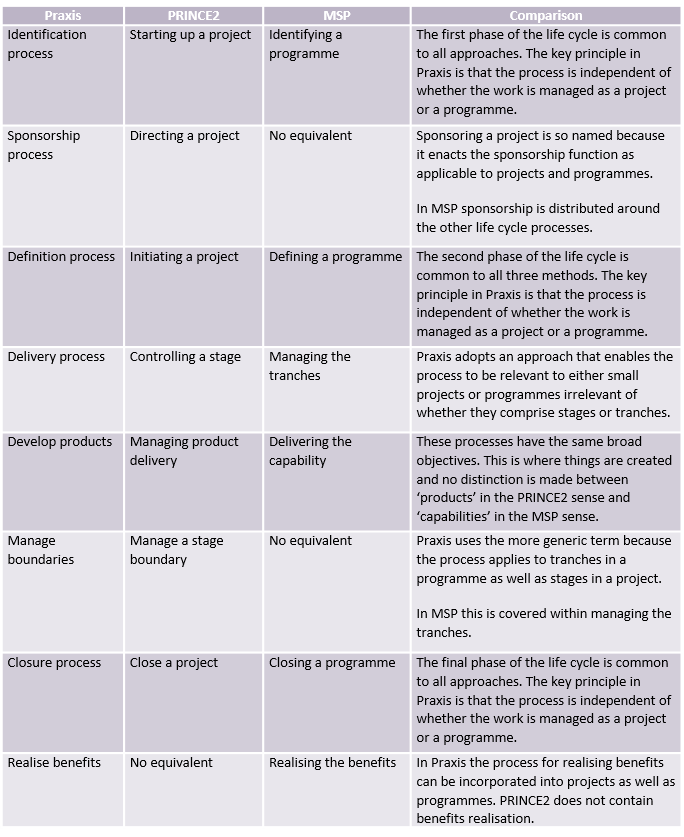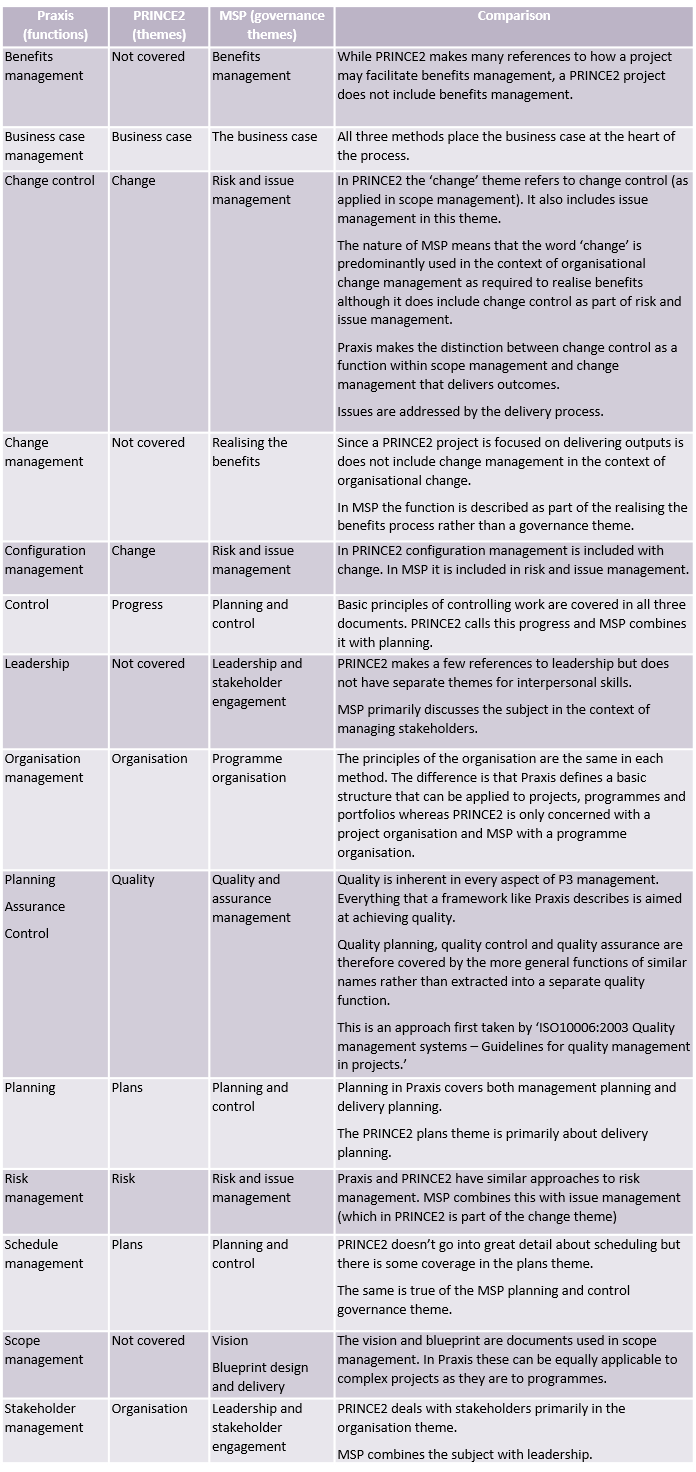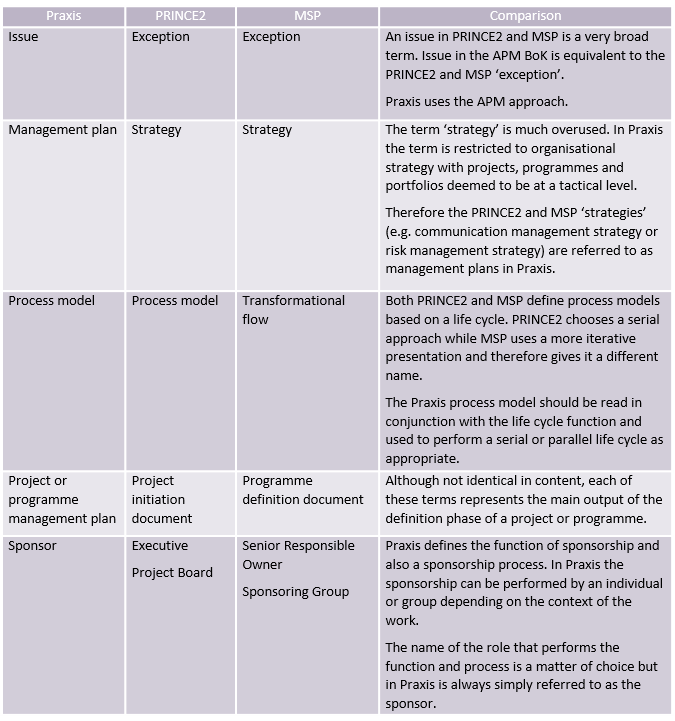Introduction
Anyone familiar with either PRINCE2®1 or Managing Successful Programmes®2 (MSP) will immediately recognise much of the method section of Praxis. This is because, like most methods, all three are based on a common life cycle where each life cycle phase is implemented through a corresponding process.
However, Praxis is not just a process model. It also contains sections describing knowledge, competence and capability maturity, and is designed to be adaptable to a wider range of contexts. PRINCE2 and MSP both promote the idea that they should be tailored to suit different contexts but they are sufficiently prescriptive that they can be used ‘out of the box’ and this inevitably leads to some limitations.
 The creation of a more flexible and adaptable method comes at a price. Using Praxis requires greater knowledge of the underlying principles in order to tailor it to any given situation.
The creation of a more flexible and adaptable method comes at a price. Using Praxis requires greater knowledge of the underlying principles in order to tailor it to any given situation.
This article explains the key differences of principle between Praxis, PRINCE2 and MSP. Either PRINCE2 or MSP could be adapted to use the Praxis terminology so that they effectively become tailored project and programme methods within the overall Praxis framework.
Key differences
Project or programme
PRINCE2 is a project management method and MSP is a programme management method. The two are seen as distinct approaches.
Praxis takes the view that projects and programmes are less easily distinguished. The decision whether to manage a piece of work as a project or a programme is dependent upon its context and complexity. The two approaches are very similar and simply represent points on a scale of complexity. Many pieces of work may be managed using a combination of both.
Benefits management
There is an assumption in PRINCE2 and MSP that projects only deliver outputs and any benefits will be delivered by a programme.
Praxis takes the view that projects can include benefits realisation. The distinction between projects and programmes in Praxis is one of complexity. Therefore where a piece of work delivers one output and one benefit it is probably a ‘project that includes benefits realisation’. Where a piece of work delivers multiple outputs that have complex relationships with multiple benefits it should be managed as a programme. There are many scenarios in between where the choice of ‘complex project’ vs. ‘non-complex programme’ is a matter of choice.
Function or theme?
Subjects such as risk management or leadership etc. are the functions that make up the discipline of P3 management. Praxis calls these ‘functions’ because they are normally identified for any discipline through a mechanism called ‘functional analysis’. In PRINCE2 and MSP these are referred to as ‘themes’ or ‘governance themes’ respectively.
The Praxis functions are based on the Association for Project Management’s Body of Knowledge3 and represent the full range of functions that make up the discipline of P3 management. There are many functions that are not represented as themes in PRINCE2 or governance themes in MSP; for example procurement. The Praxis method incorporates all functions in a way that will be familiar to PRINCE2 and MSP users.
Product-based planning
Product-based planning is an approach that is central to the scope management in a PRINCE2 project. To some degree this is a legacy of PRINCE2’s heritage and is not applicable, in its entirety, to all contexts.
Praxis treats product-based planning as just one of the many ways in which scope may be managed and doesn’t give it such a central role in the process model. This also enables processes to be common to projects and programmes.
Processes
The following table provides a high level comparison of the process models of Praxis, PRINCE2 and MSP.

Themes
The following table provides a high level comparison of the relevant functions from Praxis, themes from PRINCE2 and the governance themes from MSP. Only functions that have some coverage in PRINCE2 and MSP are included. Functions such as procurement that are not addressed by either PRINCE2 or MSP are not included in the table.

Terminology
The following table explains any significant differences in terminology between the three methods.

References
- Axelos, (2017), Managing Successful Projects with PRINCE2, TSO, London
- Axelos, (2011), Managing Successful Programmes, TSO, London
- Association for Project Management (APM), 2012, Body of Knowledge 6th Edition, Princes Risborough





